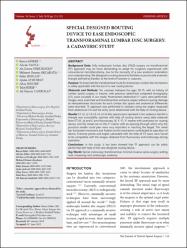Special designed routing device to ease endoscopic transforaminal lumbar disc surgery: A cadaveric study

Göster/
Erişim
info:eu-repo/semantics/openAccessTarih
2019Yazar
Göker, BurcuTahta, Alican
Yörükoğlu, Ali
Akçakaya, Mehmet
Şencan, Fahir
Aydoseli, Aydın
Sencer, Altay
Kırış, Talat
Canbolat, Ali
Üst veri
Tüm öğe kaydını gösterKünye
Göker, B., Tahta, A., Yörükoğlu, A., Akçakaya, M., Şencan, F., Aydoseli, A. ... Canbolat, A. (2019). Special designed routing device to ease endoscopic transforaminal lumbar disc surgery: A cadaveric study. Journal of Turkish Spinal Surgery, 30(3). 211-221.Özet
Background Data: Fully endoscopic lumbar disc (FELD) surgery via transforaminal
(TF) approach may be more demanding to adopt for surgeons experienced with
conventional microdiscectomy, due to the necessity of a new anatomic orientation
and understanding. We designed a routing device to facilitate access to safe anatomic
triangle defined by Kambin at the level of foramen in cadavers.
Purpose: To show that the transforaminal route for endoscopic lumbar disc herniations
is safely applicable with the aid of a new routing device.
Materials and Methods: Ten cadavers between the ages 18-75, with no history of
lumbar spinal surgery or trauma, with previous abdominal computed tomography
(CT) scans included in our study. Postmortem abdominal CT scans were performed.
Images were examined and transforaminal entrance angles without causing damage
to retroperitoneal structures for each lumbar disc space and anatomical differences
were recorded. TF approach was performed in cadavers using the angles measured
from abdominal CTs and the entry point determined with the help of routing device.
Results: L1-L2, L2-L3, L3-L4, L4-L5 disc spaces were operated in ten cadavers. Kambin’s
triangle was successfully reached with help of routing device using data obtained
from CT (X’, α) and C-arm fluoroscopy (X, Y, Y’). Y’ marker with protractor on routing
device, and the metal rod on this Y’ marker with an opening through which only the
punction needle could pass were very important in reaching the target. The metal
bar horizontal movement and fixation to this mechanism contributed to operation of
device. Entrance points and angles calculated with the help of CT scans were found
to be compatible with the images obtained from fluoroscopy and endoscopy during
operation.
Conclusions: In this study, it has been showed that TF approach can be safely
performed with help of the new designed routing device.
Kaynak
Journal of Turkish Spinal SurgeryCilt
30Sayı
3Koleksiyonlar
- Makale Koleksiyonu [3790]
- TR-Dizin İndeksli Yayınlar Koleksiyonu [2179]

















